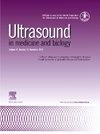Integration of Anterior and Posterior Ultrasonography for Comprehensive Anterior Cruciate Ligament Visualization: A Novel Approach
IF 2.4
3区 医学
Q2 ACOUSTICS
引用次数: 0
Abstract
Objective
Alternative medical imaging techniques are necessary to address the limitations of magnetic resonance imaging (MRI). Therefore, this study aimed to develop an ultrasonographic method that integrates anterior and posterior approaches for measuring the entire length of the anterior cruciate ligament (ACL). We validated this method by identifying the middle ACL during arthroscopy and comparing the results to those of MRI. We hypothesized that the ACL length measurements obtained via ultrasonography and MRI would not differ significantly and that the posterior approach would provide a longer visual field of the ACL than the anterior approach.
Methods
Thirty-six patients (21 males, 15 females) diagnosed with meniscal injury or internal knee derangement were included. During arthroscopy, the surgeon identified the middle ACL using Ti-Cron™ sutures. Ultrasonographic approaches from the anterior and posterior perspectives were used to identify the distal and proximal ACL, respectively. The ACL length was measured using both ultrasonography and MRI, and the visual fields from both approaches were compared.
Results
One participant was excluded because of a torn ACL, and seven participants were excluded because of poor ultrasonographic image quality. The ACL length of the 28 included patients did not differ significantly between ultrasonography and MRI, with a moderate correlation between the two measurements. The visualized proportion of the ACL was greater through the posterior approach than through the anterior approach.
Conclusions
This ultrasonographic method visualizes the entire ACL length by combining anterior and posterior approaches, with the posterior offering a more extensive and clinically significant visual field.
前、后超声综合前交叉韧带显示:一种新方法。
目的:为了解决磁共振成像(MRI)的局限性,有必要采用替代医学成像技术。因此,本研究旨在发展一种综合前后路的超声检查方法来测量前交叉韧带(ACL)的全长。我们通过在关节镜下识别中间前交叉韧带并将结果与MRI结果进行比较来验证该方法。我们假设通过超声和MRI获得的ACL长度测量值不会有显著差异,并且后路入路比前路入路提供更长的ACL视野。方法:36例诊断为半月板损伤或膝关节内部脱位的患者(男21例,女15例)。在关节镜检查中,外科医生使用Ti-Cron™缝合线确定了中间ACL。超声检查方法分别从前、后角度确定远端和近端前交叉韧带。使用超声和MRI测量ACL长度,并比较两种方法的视野。结果:1例患者因前交叉韧带撕裂被排除,7例患者因超声图像质量差被排除。28例患者的ACL长度在超声检查和MRI检查之间没有显著差异,两者之间有适度的相关性。经后路比经前路可见前交叉韧带的比例更大。结论:该超声检查方法通过前后路结合的方式显示整个ACL长度,其中后路提供了更广泛和具有临床意义的视野。
本文章由计算机程序翻译,如有差异,请以英文原文为准。
求助全文
约1分钟内获得全文
求助全文
来源期刊
CiteScore
6.20
自引率
6.90%
发文量
325
审稿时长
70 days
期刊介绍:
Ultrasound in Medicine and Biology is the official journal of the World Federation for Ultrasound in Medicine and Biology. The journal publishes original contributions that demonstrate a novel application of an existing ultrasound technology in clinical diagnostic, interventional and therapeutic applications, new and improved clinical techniques, the physics, engineering and technology of ultrasound in medicine and biology, and the interactions between ultrasound and biological systems, including bioeffects. Papers that simply utilize standard diagnostic ultrasound as a measuring tool will be considered out of scope. Extended critical reviews of subjects of contemporary interest in the field are also published, in addition to occasional editorial articles, clinical and technical notes, book reviews, letters to the editor and a calendar of forthcoming meetings. It is the aim of the journal fully to meet the information and publication requirements of the clinicians, scientists, engineers and other professionals who constitute the biomedical ultrasonic community.

 求助内容:
求助内容: 应助结果提醒方式:
应助结果提醒方式:


